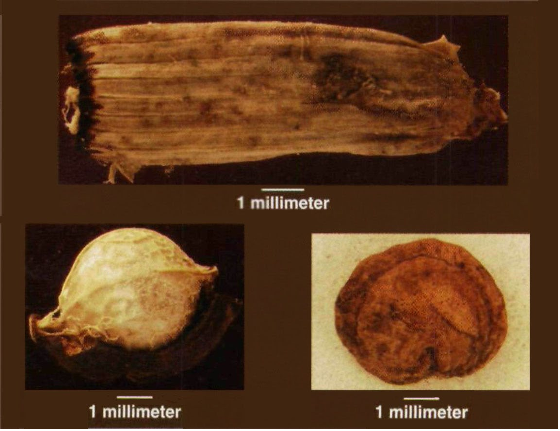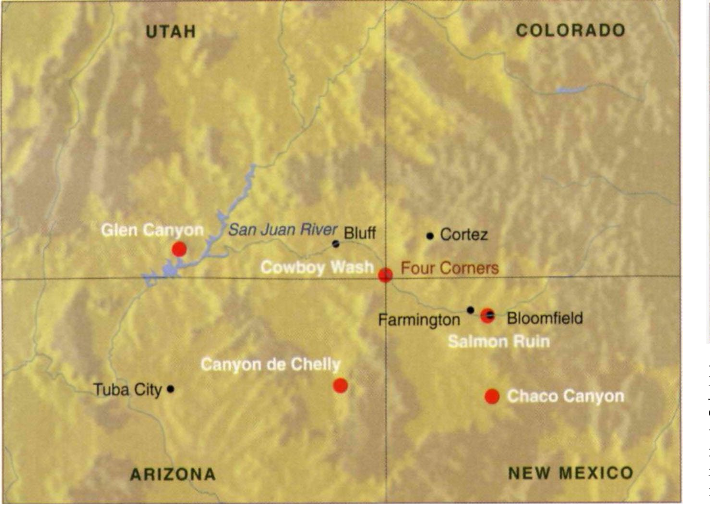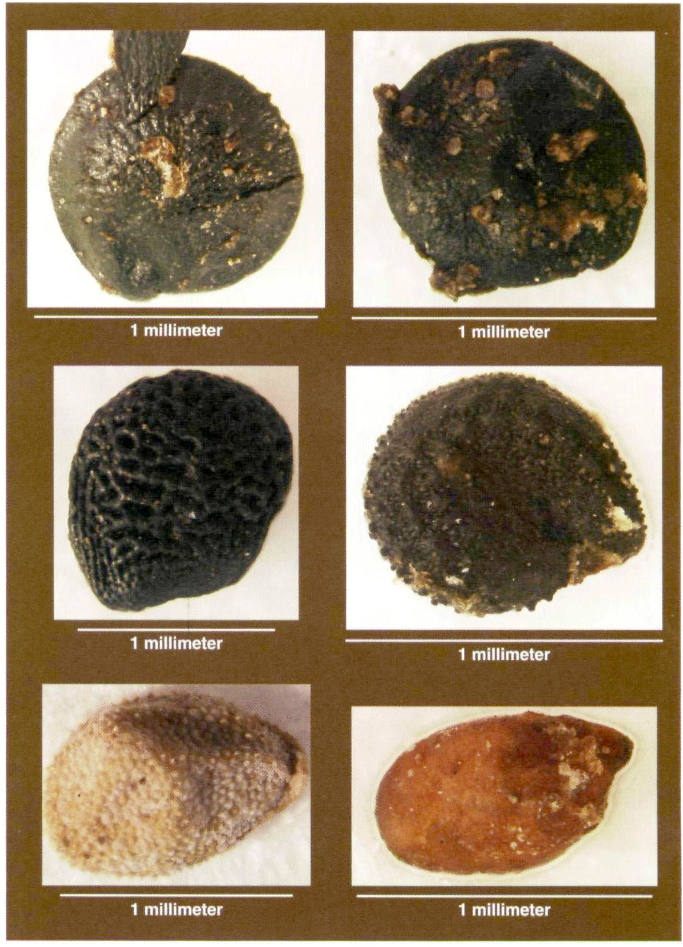
University of Nebraska - Lincoln
DigitalCommons@University of Nebraska - Lincoln
Karl Reinhard Papers/Publications Natural Resources, School of
5-2006
A Coprological View of Ancestral Pueblo
Cannibalism
Karl Reinhard
University of Nebraska-Lincoln, kreinhard1@mac.com
Follow this and additional works at: h9p://digitalcommons.unl.edu/natresreinhard
Part of the Archaeological Anthropology Commons, Ecology and Evolutionary Biology
Commons, Environmental Public Health Commons, Other Public Health Commons, and the
Parasitology Commons
8is Article is brought to you for free and open access by the Natural Resources, School of at DigitalCommons@University of Nebraska - Lincoln. It
has been accepted for inclusion in Karl Reinhard Papers/Publications by an authorized administrator of DigitalCommons@University of Nebraska -
Lincoln.
Reinhard, Karl, "A Coprological View of Ancestral Pueblo Cannibalism" (2006). Karl Reinhard Papers/Publications. 26.
h9p://digitalcommons.unl.edu/natresreinhard/26

254
A
s the object of my scientic study,
I’ve chosen coprolites. It’s not a
common choice, but to a paleonutri-
tionist and archaeoparasitologist, a
coprolite—a sample of ancient feces
preserved by mineralization or simple
drying—is a scientic bonanza. Analy-
sis of coprolites can shed light on both
the nutrition of and parasites found in
prehistoric cultures. Dietary reconstruc-
tions from the analysis of coprolites can
inform us about, for example, the ori-
gins of modern Native American diabe-
tes. With regard to parasitology; copro-
lites hold information about the ancient
emergence and spread of human infec-
tious disease. Most sensational, how-
ever, is the recent role of coprolite anal-
ysis in debates about cannibalism.
Most Americans know the people
who lived on the Colorado Plateau
from 1200 B.C. onward as the Anasazi,
a Navajo (or Dine) word. The modern
Pueblo people in Arizona and New
Mexico, who are their direct descen-
dants, prefer the description Ancestral
Pueblo or Old Ones. Because the image
of this modern culture could be tainted
by the characterization of their ances-
tors, it’s especially important that ar-
chaeologists and physical anthropol-
ogists come to the correct conclusion
about cannibalism. This is the story of
my involvement in that effort.
When a coprolite arrived in my lab-
oratory for analysis in 1997, I didn’t
imagine that it would become one of
the most contentious nds in archaeo-
logical history. Banks Leonard, the Soil
Systems archaeologist who directed ex-
cavation of the site at Cowboy Wash,
Utah, explained to me that there was
evidence of unusual dietary activity by
the prehistoric individual who depos-
ited the coprolite. He or she was possi-
bly a cannibal.
I had been aware of the cannibalism
controversy for a number of years, and
I was interested in evaluating evidence
of such activity. But from my scientic
perspective, it was simply another sam-
ple that would provide a few more data
points in my reconstruction of ancient
diet from a part of the Ancestral Pueblo
region that was unknown to me.
The appearance of the coprolite was
unremarkable—in fact, it was actually
a little disappointing. It looked like a
plain cylinder of tan dirt with no obvi-
ous macrofossils or visible dietary in-
clusions. I have analyzed hundreds of
Ancestral and pre-Ancestral Pueblo
coprolites that were more interesting.
Indeed, I have surveyed tens of thou-
sands more that, to my experienced eye,
held greater scientic promise. Yet this
one coprolite, when news of it hit the
media, undid 20 years of my research
on the Ancestral Pueblo diet. On a
broader scale, it caused the archaeolog-
ical community to rethink our percep-
tion of the nature of this prehistoric cul-
ture and to question what is reasonable
scientic proof.
Cannibalism, Without Question
In the arid environment of the U.S.
Southwest, feces dried in ancient throes
provide a 9,000-year record of gastro-
nomic traditions. This record allows me
and a few other thick-skinned research-
ers to trace dietary history in the deserts.
(I say “thick-skinned,” because analysts
generally don’t last long in this specialty.
Many have done one coprolite study,
only to move on to a more socially ac-
ceptable archaeological specialty.)
From the mid-1980s to the mid-’90s, I
had characterized the Ancestral Pueblo
lifestyle as a combination of hunting
and gathering mixed with agriculture
based on the analysis of about 500 cop-
rolites from half a dozen sites. Before
me, Gary Fry, then at Youngstown State
University, had come to the same con-
clusion in work he published during
the ‘70s and ‘80s, based on the analysis
of a large number of Ancestral Pueblo
coprolites from many sites. These peo-
ple were nely attuned to the diverse
and complicated habitats of the Colo-
rado Plateau for plant gathering, as well
as for plant cultivation. The Ancestral
Pueblo certainly ate meat—many kinds
of meat—but never had there been any
indication of cannibalism in any copro-
lite analysis from any site.
The evidence for cannibalism at
Cowboy Wash has been widely pub-
lished. A small number of people were
Published in American Scientist 94:3 (May/June 2006), pp. 254-261.
Copyright © Sigma XI Science Research Society. Used by permission.
A Coprological View of Ancestral Pueblo
Cannibalism
Debate over a single fecal fossil offers a cautionary tale
of the interplay between science and culture
Karl J. Reinhard
Karl J. Reinhard is a professor in the School of Natural Resources at the University of Nebraska and a Fulbright Commission Senior Specialist
in Archaeology for 2004-2009. The main focus of his career since earning his Ph.D. from Texas A&M has been to nd explanations for mod-
ern patterns of disease in the archaeological and historic record. He also developed a new specialization called archaeoparasitology, which
attempts to understand the evolution of parasitic disease. Address: 309 Biochemistry Hall, University of Nebraska, Lincoln, NE 48503-0578.
Figure 1. What was the nature of the people
who occupied much of the Colorado Plateau
for two and a half millennia up until about
1300 A.D.? Commonly known by the Navajo
term Anasazi, the Ancestral Pueblo were
considered the “peaceful people” until they
were accused of cannibalism in 1990s. The
answer is more than academic, as their de-
scendants still occupy the southerly reaches
of the Ancestral Pueblo domain. The author
has studied hundreds of Ancestral Pueblo
coprolites—dried or fossilized feces—and
has found all but one to contain residues of a
diverse mixture of plant matter, both domes-
ticated and wild, and meat. Only one shows
evidence of cannibalism. Should that single
sample be used to condemn an entire cul-
ture? The human efgy shown here is from
Pueblo III culture, circa 700-1100 A.D.

A Co pr o lo g iC A l Vi e w o f AnC e st r Al pu e bl o CA n n i b A li s m 255
The Art Archive/Southwest Museum/Pasadena/Laurie Pratt Winfrey

256 KAr l re in h Ar d i n A m e r i c A n S c i e n t i S t 94:3 (m A y /Jun e 2006)
undoubtedly killed, disarticulated and
their esh exposed to heat and boiling.
This took place in a pit house typical
of the Ancestral Pueblo circa 1200 A.D.
At the time of the killings, the appear-
ance of the pit house must have been
appallingly gruesome. Human blood
residue was found on stone tools, and
I imagine that the disarticulation of
the corpses must have left a horrifying
splatter of blood around the room. But
the most conclusive evidence of can-
nibalism did not come from the room
where the corpses were dismembered.
It came from a nearby room where
someone had defecated on the hearth
around the time that the killings took
place. The feces was preserved as a cop-
rolite and would turn out to be the con-
clusive evidence of cannibalism.
My analysis of the coprolite was not
momentous. I could determine from
its general morphology that it was in-
deed from a human being. However,
the tiny fragment that I rehydrated
and examined by several microscopic
techniques contained none of the typ-
ical plant foods eaten by the Ances-
tral Pueblo. Background pollen of the
sort that would have been inhaled or
drunk was the only plant residue that
I found. Thus, I concluded that the cop-
rolite did not represent normal Ances-
tral Pueblo diet. It seemed to represent
a purely meat meal, something that is
unheard of from Ancestral Pueblo cop-
rolite analyses.
After analyzing the Cowboy Wash
coprolite, I took a half-year sabbatical
as a Fulbright scholar in Brazil. When
I returned, I learned that my analysis
had been superseded by a new technol-
ogy. Richard Marlar from the Univer-
sity of Colorado School of Medicine and
colleagues had taken over direct anal-
ysis of the coprolite using an enzyme-
linked immunosorbent assay to detect
human myoglobin, and their work had
conrmed and expanded my analysis.
The coprolite was from a human who
had eaten another human. The technical
paper appeared in Nature and was fol-
lowed by articles in the New Yorker, Dis-
cover, Southwestern Lore and the Smith-
sonian, among many others. The articles
became the focus of a veritable explo-
sion of media pieces in the press, on ra-
dio and television, and on the Internet,
amounting to an absolute attack on An-
cestral Pueblo culture.
Initially, I sat and watched the me-
dia feeding frenzy and Internet chat de-
bates with a sense of awe and post-sab-
batical detachment. My original report
suggesting the coprolite was not of An-
cestral Pueblo origin went largely unno-
ticed. The few journalists who did call
me for an opinion proved uninterested
in publishing it. In some cases it was too
far to y to Nebraska to lm; in others
my opinion didn’t t into the context of
the debate. Well, I have looked at more
Ancestral Pueblo feces than any other
human being, and I do have an opinion:
The Ancestral Pueblo were not canni-
balistic. Cannibalism just doesn’t make
sense as a pattern of diet for people so
exquisitely adapted to droughts by cen-
turies of hunting-gathering traditions
and agricultural innovation.
Then a media quote knocked me out
of my stupor. Arizona State University
anthropologist (emeritus) Christy G.
Turner II, commenting in an interview
about a book he co-authored on Ances-
tral Pueblo cannibalism, said, “I’m the
guy who brought down the Anasazi.”
Perhaps to temper Turner’s broad gen-
eralization, Brian Billman (a coauthor of
the Marlar Nature paper) of the Univer-
sity of North Carolina at Chapel Hill,
suggested that a period of drought
brought on emergency conditions that
resulted in cannibalism. Beyond the sci-
entic quibbling about who ate whom
and why, I am amazed at the vortex of
debate around the Coyote Wash copro-
lite. The furor over that one coprolite
represents a new way of thinking about
the Ancestral Pueblo and archaeologi-
cal evidence.
What Did the Ancestral Pueblo Eat?
To me, a specialist in Ancestral
Pueblo diet, neither Turner’s nor Bill-
man’s explanation made sense. So, in
the years since the Nature paper ap-
peared in 2000, I have renewed my
analyses of Ancestral Pueblo coprolites
to understand just what they did eat in
times of drought. And let me say em-
phatically that Ancestral Pueblo cop-
rolites are not composed of the esh of
their human victims. Some of their di-
etary practices were, perhaps, peculiar.
I still recall in wonderment the inch-di-
ameter deer vertebral centrum that I
found in one sample. It was swallowed
whole. The consumption of insects,
snakes and lizards brought the Ances-
tral Pueblo notice in the children’s book
It Was Disgusting and I Ate It. But look-
Figure 2. Cowboy Wash, Utah, near the San
Juan River and Four Corners, is the only An-
cestral Pueblo archaeological excavation to
turn up coprological evidence of cannibal-
ism. Evidence from other sites (red dots) con-
rms the people’s diverse diet. (Topographic
map courtesy of the U.S. Geological Survey.)

A Co pr o lo g iC A l Vi e w o f AnC e st r Al pu e bl o CA n n i b A li s m 257
ing beyond such peculiarities, their diet
was delightfully diverse and testies to
the human ability to survive in the most
extreme environments. To me, diet is
one the most fundamental bases of civ-
ilization, and the Ancestral Pueblo pos-
sessed a complicated cuisine. They were
gastronomically civilized.
Widespread analysis of coprolites
by “paleoscatologists” began in the
1960s and culminated in the ‘70s and
‘80s when graduate students worked
staunchly on their coprological theses
and dissertations. From Washington
State University, to Northern Arizona
University to Texas A & M and many
more, Ancestral Pueblo coprolites were
rehydrated, screened, centrifuged and
analyzed. Richard Hevly, Glenna Wil-
liams-Dean, John Jones, Mark Stiger,
Linda Scott-Cummings, Kate Aasen,
Gary Fry, Karen Clary, Molly Toll and
Vaughn Bryant, Jr., to name a few,
joined me in puzzling over Ancestral
Pueblo culinary habits. In their consci-
entious and rigorous research, the same
general theme emerged. The Ancestral
Pueblo were very well adapted to the
environment, both in times of feast and
in times of famine.
In general, the Ancestral Pueblo diet
was the culmination of a long period
of victual tradition that began around
9,000 years ago, when people on the
Colorado Plateau gave up hunting big
animals and started collecting plants
and hunting smaller animals. Prickly
pear cactus, yucca, grain from drop-
seed grass, seeds from goosefoot and
foods from 15 other wild plants dom-
inated pre-Ancestral Pueblo life. One
of the truly interesting dietary patterns
that emerged in the early time and con-
tinued through the Ancestral Pueblo
culture was the consumption of pol-
len-rich foods. Cactus and yucca buds
and other owers were the sources of
this pollen. Rabbit viscera probably pro-
vided a source of fungal spores of the
genus Endogane, although I doubt that
these people knew they were eating the
spores when they ate the rabbits. The
pre-Ancestral Pueblo people adapted to
starvation from seasonal food shortages
by eating yucca leaf bases and prickly
pear pads and the few other plants that
were available in such lean times.
Prey for the pre-Ancestral Pueblo peo-
ple included small animals such as rab-
bits, lizards, mice and insects. In tact,
most pre-Ancestral Pueblo coprolites
contain the remains of small animals.
My analysis of these remains shows that
small animals, especially rabbits and
mice, were a major source of protein in
summer and winter, good times and bad.
The Ancestral Pueblo per se de-
scended from this hunter-gatherer tra-
dition. Coprolite analysis shows that
they were largely vegetarian, and plant
foods of some sort are present in ev-
ery Ancestral Pueblo coprolite I have
analyzed. But these later people also
expanded on their predecessors’ cui-
sine. They cultivated maize, squash
and eventually beans. Yet they contin-
ued to collect a wide diversity of wild
plants. They actually ate more species of
wild plants—more than 50—than their
ancestors who were totally dependent
on wild species.
Adapting to the Environment
In 1992, I presented a series of hy-
potheses addressing why the Ancient
Pueblo ate so many species of wild
plants. Later, Mark Stiger of Western
State College and I went to work on the
problem using a statistical method that
he devised. We determined that the An-
cestral Pueblo encouraged the growth
of edible weedy species in the distur-
bances caused by cultivation and vil-
lage life. In doing so, they increased the
spectrum of wild edible plants avail-
able to them, often using them to spice
Figure 3. Small seeds were an important part of the Ancestral Pueblo diet. Because they are
typically quite small and are often fragmented from stone grinding, their identication in cop-
rolites can be difcult. Shown here (clockwise, from upper left) are seeds of pigweed, goose-
foot, purslane, dropseed grass, an unknown seed present in on|y one sample and hedge-
hog-cactus fruit. These are only a few examples of the seeds that the Ancestral Pueblo ate.
(Vegetation photographs by the author.)




